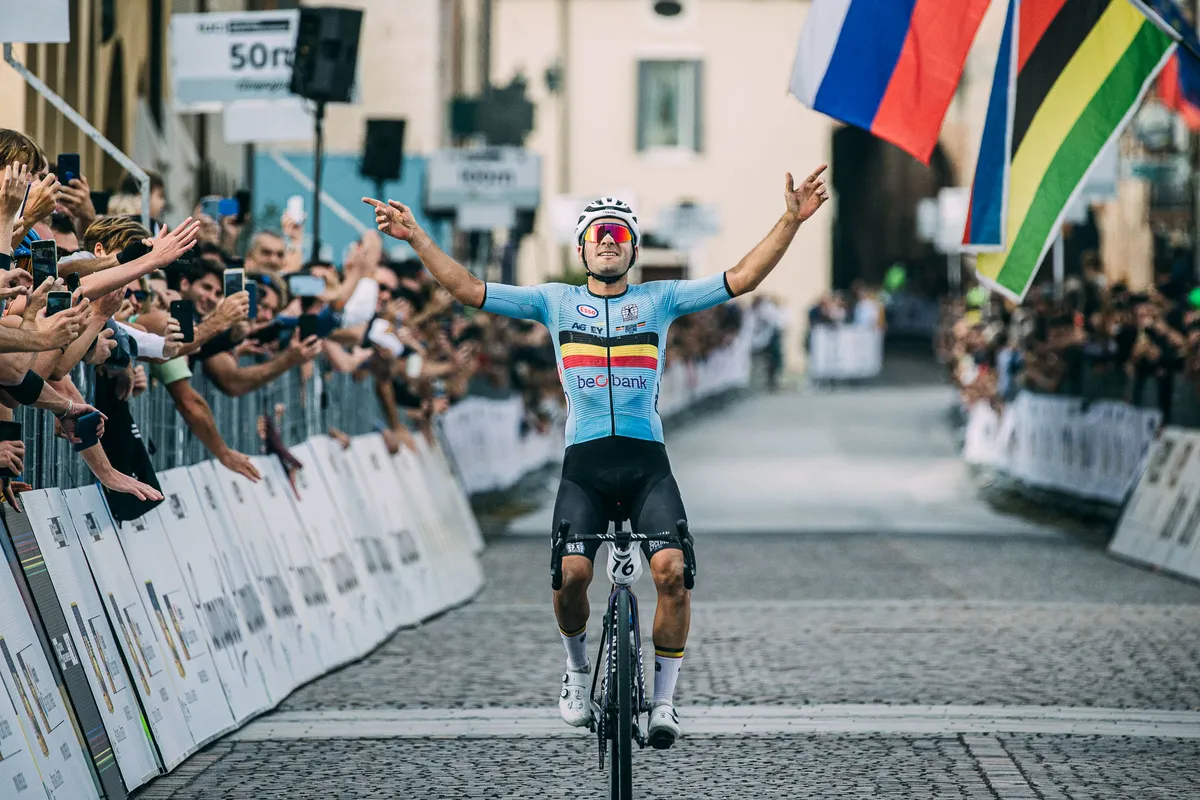Belgium's Gianni Vermeersch soloed to victory to claim the men's rainbow jersey at the inaugural UCI Gravel World Championships – riding a road bike.
Having established a two-man breakaway with Italy's Daniel Oss with 130km of the 194km course to race, Vermeersch attacked with 10km remaining aboard a Canyon Ultimate CFR shod with Vittoria Terreno Dry tubeless gravel tyres (33mm at the front, 35mm at the rear).
Vermeersch's Alpecin-Deceuninck team-mate and pre-race tip Mathieu van der Poel finished third to round out a podium dominated by WorldTour pros, in a race that favoured the road stars dipping their toe into gravel, over the gravel specialists, including 2022 Unbound winner Ivar Slik.
That was reflected in equipment choices, too. With only 800m of climbing and hard-packed conditions, some riders opted for road frames and gearing, with gravel tyres swapped in, over specialist gravel machines (we saw the same trend in the elite women's race).
Vermeersch, who cut his teeth in cyclocross, and van der Poel were among the WorldTour pros on the start line on road bikes, while Oss (along with Peter Sagan) was riding a Specialized Roubaix endurance road bike with gravel tyres.
An Ultimate in gravel disguise

Canyon has two gravel platforms in its range: the Grail, complete with double-decker handlebar, and Grizl, aimed at more rugged riding and bikepacking.
However, having detoured into gravel at the end of the road season, Vermeersch (and van der Poel) opted for the new Canyon Ultimate, launched only in September.
It's an evolutionary update of the previous Ultimate, with subtle aero tweaks and, crucially as far as this race was concerned, increased tyre clearance.

Canyon quotes a maximum tyre clearance of 32mm for the new Ultimate but, as is typically the case, there's room to run a larger tyre than the brand officially recommends.
Vermeersch's mechanic squeezed in 35mm rubber at the rear and 33mm at the front, owing to the tighter fork clearance, according to Bici da Strada.

The lack of both climbing and technical terrain at the inaugural UCI-sanctioned Gravel World Championships has put the event at odds with trailblazing gravel races such as Unbound.
However, the evolution of the best road bikes – notably the adoption of disc brakes and the increased tyre clearances that have followed – has enabled top-tier race machines to feature when, just a few years ago, an event such as this would have been the preserve of cyclocross or gravel bikes.

The Vittoria Terreno Dry tyres used by both Vermeersch and van der Poel were a popular option across the men's and women's elite races at the gravel worlds – and are among the best gravel tyres we've tested.

The tyre features a scaled pattern on the centre strip, combined with a more pronounced tread on the shoulders.
As the name suggests, this is a tyre for dry conditions, with Vittoria describing it as an option that bridges the gap between a file tread tyre and more aggressive all-weather rubber.

Vermeersch ran the tyres tubeless on a set of low-profile Shimano Dura-Ace C36 wheels.
Flat-out fast

The 29-year-old's gearing was representative of the fast course, with a road setup – Shimano Dura-Ace Di2 with a double crankset – over gravel-specific gearing.

Vermeersch was using semi-compact 52-36t chainrings, though, and the 11-34t cassette now available with Dura-Ace ensured an appropriate spread of gears for road and off-road riding.

Other spec details include Canyon's Aerocockpit, with a 110mm stem and handlebar that can be adjusted between 390mm and 430mm.
There's also a Selle Italia Flite Superflow saddle.

On the Elite Prism bottle cage mounted to the down tube, you can also see a Vittoria Pit Stop kit, in the event of Vermeersch requiring hasty inflation in a race devoid of the useful mechanical support seen in WorldTour road races.

Subtle tweaks

Back to the Ultimate, and the geometry of Canyon's updated all-rounder has been tweaked to match that of the Aeroad aero bike.

In terms of aero improvements, the Ultimate's tubes are slightly more angular than the outgoing version, and that's most noticeable below the fork crown.

Canyon claims a drag saving of five watts at 45kph, while the fork design yields a 15 per cent boost in stiffness, according to the German brand.
Regardless of those claims, it's proved itself to be a versatile machine with Vermeersch aboard.
